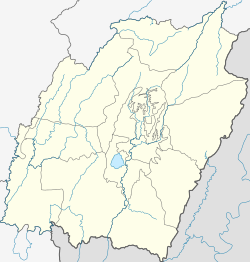Ankhasuo
Ankhasuo
Sibapurikhal | |
|---|---|
Village | |
| Coordinates: 24°34′09″N 93°04′55″E / 24.5691°N 93.0820°E | |
| Country | |
| State | Manipur |
| District | Pherzawl |
| Population (2011)[1] | |
• Total | 1,841 |
| Language(s) | |
| • Official | Meitei |
| Time zone | UTC+5:30 (IST) |
| Vehicle registration | MN |
| Website | manipur |
 | |
Ankhasuo, also called Sibapurikhal,[a] is a census village in the Vangai Range subdivision, Pherzawl district, Manipur, India.[1] The village is on the bank of the Barak River, close to the border between Pherzawl and Jiribam districts. Savomphai, the next village to the north is the last village in Pherzawl district. Other villages in the vicinity are Kasurbali[b] and Khangbor, the latter of which is enumerated within Ankhasuo for the census.
The Barak River flows north in this region, up to Jirimukh, where it turns northwest. The Barak River also forms the border with the Assam state of India.
Geography and History
[edit]The entire Vangaitang range was part of the Cachar kingdom at the beginning of the 19th century. After annexing the kingdom in 1832, the British transferred the Vangaitang range to Manipur, setting the border along the western stretch of Barak River[c] and the Jiri River.[3][4]
In 1907, the Manipur government opened the "Jiribam valley" between the rivers and the Vangaitang range for agricultural settlement,[5] which attracted settlers from Cachar, including Bengalis as well as Meiteis.[6] The Vangaitang range is the traditional abode of the Hmar tribes.
Independent India
[edit]After the independence of India, a Jiribam subdivision was defined in Manipur to encompass the Vangaitang range from the east–west stretch of the Jiri River in the north to Tipaimukh in the south.[7] The 1956 listing of villages in the subdivision includes Kosurbali and Shibapurikhal.[2] In 1958, Sibapurikhal was listed one of the 16 village authorities in the Jiribam subdivision.[8]
In due course, the southern and eastern hill regions were transferred to the Churachandpur district (now Pherzawl district), leaving only the valley and some of the foothills regions in the Jiribam subdivision.[7] The border between the Jiribam and Pherzawl districts runs between Choudhurikhal and Savomphai.[1]
The Jiribam–Tipaimukh Road ("JT Road"), which is the only state-level highway in the Jiribam district, runs through the region. Near the Khangbor village, it begins its climb the Vangaitang range, and runs on the ridge top on its way south.
In 2012, the fifth round of "environmental hearings" for the proposed oil and gas exploration by Jubilant Energy in Pherzawl and neighbouring districts were held at Ankhasuo.[9] The civil society organisations of the region expressed their opposition to the exploration, citing the absence of flow of information and consensus seeking behind the efforts.[9] The convener of the Committee on Protection of Natural Resources in Manipur said that, since all five public hearings raised objections from people, Jubilant should "pack up and leave".[10]
Demographics
[edit]The Ankhasuo (Sibapurikhal) census village has a population of 1841 people living in 355 households. 92 percent of the population is made of Scheduled Tribes. The census village likely includes the Khangbor village.[1][11]
The neighbouring Kasurbali village has a population of 118 people, with only 4% belonging to Scheduled Tribes. Savomphai has a population of 442 people with 99% belonging to Scheduled Tribes.[1][11]
Notes
[edit]References
[edit]- ^ a b c d e Churachandpur District Census Handbook (PDF), Directorate of Census Operations, Manipur, 2011, p. 92
- ^ a b c "Notification No. IJ/2/56", Manipur Gazette, 16 August 1956, pp. 15–16 – via archive.org
- ^ Sanjeev, Thingnam (2015), "Recasting Space: Politics of frontier-making", in Arambam Noni; Kangujam Sanatomba (eds.), Colonialism and Resistance: Society and State in Manipur, Routledge, p. 243, ISBN 978-1-317-27066-9
- ^ Goshwami, Hareshwar (2019). History of the People of Manipur (Revised ed.). YAOL. pp. 24–25, 251. ISBN 978-1-9993057-0-3 – via archive.org.
- ^ Harvey, C. W. L. (1932), Administration Report of The Manipur State For The Year 1931-32, Imphal: The State Printing Press, p. 44 – via archive.org
- ^ Harvey, C. W. L. (1932), Administration Report of The Manipur State For The Year 1931-32, Imphal: The State Printing Press, p. 55 – via archive.org
- ^ a b Manipur Administrative Atlas (PDF), Census of India, Government of India, 2005, pp. 12–19
- ^ "Notification No. J/27(a)/54", Manipur Gazette, 21 April 1958, p. 22 – via archive.org
- ^ a b Public hearing fails to resolve oil project impasse, The Times of India, 24 November 2012. ProQuest 1190110472
- ^ Aheli Moitra, People voice out against oil exploration in Manipur, Morung Express, 23 November 2012.
- ^ a b PCA TV: Primary census abstract at town, village and ward level, Manipur - District Churachandpur - 2011, Office of the Registrar General & Census Commissioner, Government of India, 2011, PC11_PCA-TV-1403
External links
[edit]- Borobekra Subdivision, Manipur Remote Sensing Applications Centre, retrieved 8 November 2024.
- Vangai Range Subdivision, Manipur Remote Sensing Applications Centre, retrieved 8 November 2024.


